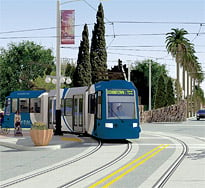If successful, Tucson’s Modern Streetcar presents opportunities for transit oriented development with myriad benefits. Early this year the Federal Transit Administration granted final approval of a $63 million dollar grant to help fund the overall $197 million cost of Tucson’s Modern Streetcar project. As of June 6th, planning is nearly complete and the 3.9 mile line is expected to go into service in 2013. The line will run from the Mission Gardens area west of Interstate 10 and Congress St, through the Central Business District, along Fourth Avenue to University Blvd, through the University of Arizona campus, and on to the University Medical Center. The streetcar line will link residential, commercial, employment, governmental, and educational activity centers in order to mitigate parking needs, improve non-vehicular connectivity, generate private development, and support population and employment growth.
Why do we need a streetcar when we already have buses?
There are two principal reasons that modern streetcars work:
- You cannot re-route a streetcar. A streetcar system is a fixed guideway transportation system- it runs on permanent rails. Unlike a bus, once a route has been chosen and the public investment has been made, it cannot be changed. The permanent nature of the routing is what helps attract private investment. The private investor/developer knows that the route cannot be changed so therefore his investment is safe.
- Buses are stigmatized. Our society is in love with the automobile. The bus is widely considered to be the transportation option for someone who cannot afford an automobile. Buses are seen as downscale and many people strongly resist taking the bus. Streetcars on the other hand have an attraction in our mindset. We see streetcars as a sophisticated urban transportation system. Streetcars attract people from all socio-economic strata and have a wider appeal.
So what can we expect from our new modern streetcar system?
Increased property values and increased private investment.
Values: Properties within 1/4-1/2 mile of streetcar lines (easy walking distance) increase in value.
- San Francisco residential values increased by 10% at BART stations
- Portland increased property values 11% within 1500’ of a station
- Santa Clara increased commercial property values by 23% along their rail line
This represents a LOT of money. Given a 1/4 mile radius around each of the planned 18 stations on the streetcar line, this represents a 10% to 20% direct increase in property value to over 1,335 acres of Tucson(over two square miles).
Private Investment: The permanent, fixed guideway, rail system attracts private money. This type of infrastructural investment cannot be changed or moved. Investment in transit oriented development will help to invigorate and revitalize areas of Tucson that have long been plagued with vacancy and low property values. Return on investment? The Portland streetcar system attracted an estimated $2.5 billion dollars in private investment based on an $89 million dollar public investment. The increased construction and elevated property values will positively impact the tax rolls for many decades.

Risks and rewards
That’s how it works. We make a permanent investment in our transportation infrastructure and the private market responds by revitalizing and rejuvenating some challenged areas of our community. The citizens (approximately 100,000 live within ½ mile of the modern streetcar line) benefit from an easy, cheap, and clean transportation mode to go to and from work, home, and entertainment.
What are the risks? When making the massive investment that a modern urban rail system requires, other municipalities have reworked land use plans and zoning to accommodate private investment. Population density and more intense commercial development are a “must” if we are to realize the return from our public investment. Compact, mixed-use, high density development must be facilitated along all sections of the streetcar route. Failure to actively plan for this investment will result in a modern streetcar that is little more than a novelty. Successfully planning for the upcoming flood of private investment dollars will ensure that future generations will benefit from our investment today.
Compact, mixed-use, high density development must be facilitated along all sections of the streetcar route. Failure to actively plan for this investment will result in a modern streetcar that is little more than a novelty. In a recent Inside Tucson Business article, Councilman Steve Kozachik states the case for zoning in advance of construction. Planning for optimal economic development along the route will best capitalize on private investment dollars, ensuring that future generations will benefit from our investment today.

Rob Tomlinson has been clearly focused on the needs of retail landlords and.jpg) tenants for over twelve years. With valuable insight on the dynamics of the site selection process, experience with assemblages, and education in Urban Geography, Site Analysis, and Land Use Planning, Rob brings an informed perspective to challenging sites. A CCIM Candidate and International Council of Shopping Centers (ICSC) member, Rob has countless hours on land use commissions and committees and public/private development efforts.
tenants for over twelve years. With valuable insight on the dynamics of the site selection process, experience with assemblages, and education in Urban Geography, Site Analysis, and Land Use Planning, Rob brings an informed perspective to challenging sites. A CCIM Candidate and International Council of Shopping Centers (ICSC) member, Rob has countless hours on land use commissions and committees and public/private development efforts.
Sources: David M Taylor, CNUSenior Vice President National Director, Sustainable Transportation Solutions david.taylor@hdrinc.com and City of Tucson Department of Transportation
Photo sources: Tucson Modern Streetcar, Regional Transportation Authority, Google Earth, Gary Rumack Photography





